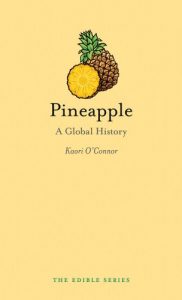‘Too ravishing for moral taste . . . like lovers’ kisses she bites – she is a pleasure bordering on pain, from the fierceness and insanity of her relish’ wrote the poet Charles Lamb about the pineapple, the fruit that seduced the world. From the moment Christopher Columbus discovered it on a Caribbean island on 4 November 1493, the pineapple became an object of passion and desire, in a culinary romance that anthropologist Kaori O’Connor follows across time and cultures.
The first New World explorers called the pineapple the apple with which Eve must have tempted Adam. Transported to Europe where it could only be grown in hothouses at vast expense, the pineapple became an elite mania, the fruit of kings and aristocrats. Soon established as the ultimate status symbol, London society hostesses would rent a pineapple at great cost for a single evening to be the centrepiece of their parties, and pineapples were as popular in the new American republic, where they were a sign of hospitality and a favourite of George Washington. Celebrated in art and literature, pineapples remained a seasonal luxury for the rich until fast shipping and then refrigeration meant they could be brought to the major markets of Europe and America, but these imported fruit were never as luscious as those eaten fresh and ripe in the tropics. Then the pineapple found its ideal home in Hawaii, the invention of canning made perfect golden fruit available and affordable all year round and the Fruit of Kings became the Queen of Fruits for all.
Pineapple is a culinary love story enriched with vivid illustrations and irresistible recipes from around the world for eating and drinking the pineapple.
The first New World explorers called the pineapple the apple with which Eve must have tempted Adam. Transported to Europe where it could only be grown in hothouses at vast expense, the pineapple became an elite mania, the fruit of kings and aristocrats. Soon established as the ultimate status symbol, London society hostesses would rent a pineapple at great cost for a single evening to be the centrepiece of their parties, and pineapples were as popular in the new American republic, where they were a sign of hospitality and a favourite of George Washington. Celebrated in art and literature, pineapples remained a seasonal luxury for the rich until fast shipping and then refrigeration meant they could be brought to the major markets of Europe and America, but these imported fruit were never as luscious as those eaten fresh and ripe in the tropics. Then the pineapple found its ideal home in Hawaii, the invention of canning made perfect golden fruit available and affordable all year round and the Fruit of Kings became the Queen of Fruits for all.
Pineapple is a culinary love story enriched with vivid illustrations and irresistible recipes from around the world for eating and drinking the pineapple.






